Flexibility to change and improve with the times became one of the primary goals of Duke University’s market street food concept in the Richard H. Brodhead Center for Campus Life when it opened in August 2016. Six years later, a refresh of 4 of the Brodhead Center’s 14 restaurant concepts and a replacement of a chain restaurant stay true to the original project team’s vision.
The Brodhead Center (BHC), which many consider an architectural marvel, sits on the west side of Duke’s campus. The BHC features dining concepts operated by highly rated local restaurateurs in the Durham area. Each concept operates independently, featuring a unique menu developed by owners and chefs, many of whom have been with the center for several years. While most are local concepts, there is also a national chain, Panera Bread.
“We want to support small local businesses,” says Robert Coffey, executive director for Duke Dining. “Many of these local operators have been on campus for multiple years.”
When designing BHC venues, Duke planned to make enhancements or total platform changes as necessary. “Each venue was constructed with its own footprint as a stand-alone restaurant with dedicated utilities and subpanels,” Coffey says. “The plan was always to do renovation enhancements to stay with or ahead of culinary trends and design with the goal of delivering a fresh, world-class, innovative dining experience at all times.”
Each restaurateur at the BHC must pass a rigorous, multilayer process of menu testing, which includes student feedback on food items. Duke oversees the operations and guides the menus and price points, also setting standards for labor, sanitation and other operational functions.
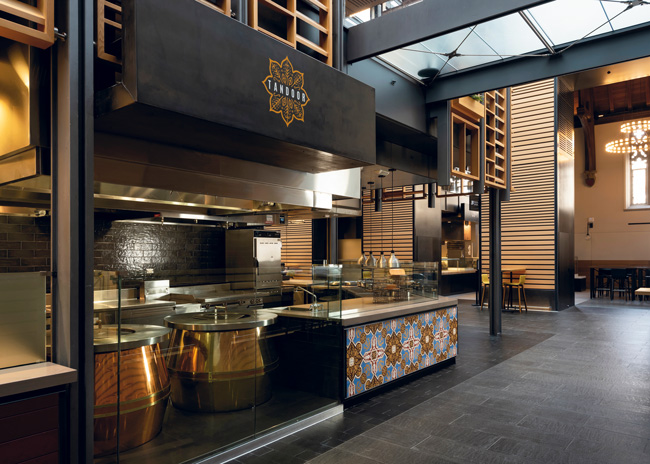 Tandoor’s copper tandoor ovens stand out as a key feature. Photos by Les Todd
Tandoor’s copper tandoor ovens stand out as a key feature. Photos by Les Todd
Duke Dining operates the BHC to cover the overhead for all concepts spaces, including back-of-the-house kitchen space that restaurants use for refrigerated, frozen and ambient storage as well as a main kitchen with more prep and cooking equipment. However, Duke does not operate the BHC for profit. Each restaurant has a separate commission-based agreement with Duke that contributes to rent, housekeeping, security and card systems. Other administrative tasks Duke helps cover include training programs, third-party inspections, achieving sustainability goals, marketing and social media.
The refresh came about to address some design and construction issues such as poor construction of the service counters, and to add new menu program enhancements to keep up with current trends and respond to customer feedback and regularly scheduled customer focus group meetings. “Once we defined the new platforms and scope of the revisions, we presented these to a student group for feedback and also conducted multiple tastings of the new menu and asked students to provide input,” Coffey says.
The refreshed concepts include a trio of local restaurant concepts — Sprout, Farmstead and Tandoor — and one Duke concept, Chef’s Kitchen. Panera Bread is a complete renovation and replaces a concept that the BHC previously operated.
“All of the foodservice venues on campus enjoy heavy traffic, much more than even a standard retail outlet,” says Ted Van Dyk, AIA, principal, New City Design Group, Raleigh, N.C. “So, our designs must include cleanability, serviceability and durability while offering an attractive, upscale presentation to the public. It’s a tall order, but a team effort, and one that continues to be successful.”
“All the original venues were constructed to code, but we could have gone further,” Coffey says. “Utilities were exposed in the back of the counters, which made cleaning difficult due to moisture seeping through.”
To address these maintenance challenges, the project team constructed a counter die wall to house all utility connections and give a proper structure to sustain the top counter and equipment. “The installation of a die wall prevents water from seeping into facades, thereby eliminating deterioration,” Coffey says. “Duke Dining staff can now properly clean under the counter around equipment and the utility connections.”
 Panera Bread’s shelving displays prepared salads ready to pick up. Simple wood panels allow the food colors and textures to stand out.
Panera Bread’s shelving displays prepared salads ready to pick up. Simple wood panels allow the food colors and textures to stand out.
Changes at the Venues
Refreshes, including replacing some equipment, also contribute to enhancing the menus.
Sprout and Farmstead swapped spaces, giving Sprout, operated by Fares Hannah of Three Seasons Catering, a 25% larger footprint to expand its increasingly popular menu of 100% vegan and raw foods. Sprout’s footprint now gives the owners more capability to expand menu offerings. New additions to Sprout include a full salad bar, a grain bar and wells for hot entrees. “No meat touches equipment, and we have dehydrators that support the raw part of the menu,” Coffey says.
All venues have their own cooking equipment; Duke provides back-of-the-house prep rooms, dry storage, refrigerators, freezers and access to a main full kitchen.
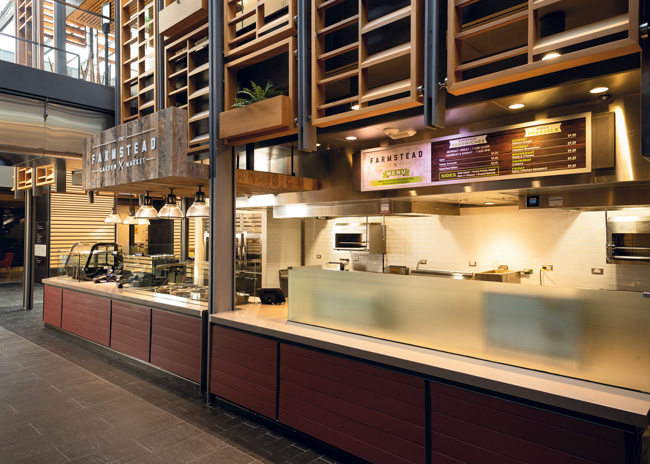 Farmstead’s finishes feature painted redwood shiplap siding, which contributes to the rustic feel of the venue’s farm-to-table options.
Farmstead’s finishes feature painted redwood shiplap siding, which contributes to the rustic feel of the venue’s farm-to-table options.
Sprout’s expanded footprint also allows for mobile ordering infrastructure, more refrigeration and hot food holding equipment. “We would have liked a living green wall in Sprout but didn’t have the space,” Coffey says.
Instead, Sprout features a live moss front counter emphasizing the fresh, healthy vegan and raw menu. Tiles contain 100% natural lichen that grows in North European forests and is harvested by hand. A specific cutting technique ensures the perfect renewing of the plant; the lichen is applied by hand.
Farmstead features a sustainable menu that uses locally sourced products. Farmstead’s finishes feature painted redwood shiplap siding. “This contributes to the rustic feel of the venue’s farm-to-table options,” says Peter J. Wentz, AIA, project architect, New City Design Group.
This garden market restaurant contains grills, induction cookers, refrigerated rails and cold pans to cook and assemble fresh garden salads, homemade soups and sandwiches such as the Farmstead burger, pulled pork from smoked paprika-roasted pork shoulder, brisket, herb-roasted chicken and grilled cheese. This restaurant also serves hot entrees such as chicken/turkey pot pie, salmon, trout, shrimp and grits, beef stew, lamb stew, meatloaf, barbecue country-style ribs and jerk chicken. Sides include kimchi slaw, maple-roasted Brussels sprouts, creamed corn and buttermilk mashed potatoes.
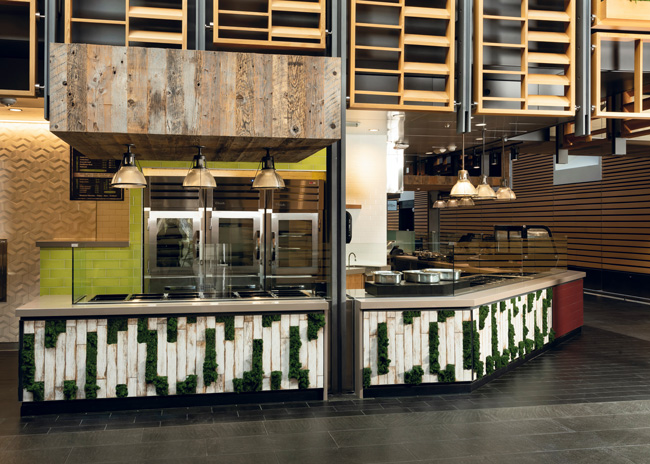 Sprout's moss front counter emphasizes the fresh, healthy vegan menu.
Sprout's moss front counter emphasizes the fresh, healthy vegan menu.
A carving station features herb-roasted chicken/turkey, slow-roasted brisket, cedar-roasted salmon, smoked paprika-roasted fresh ham, porchetta-style pork loin and garlic-roasted beef tri tip. The equipment lineup includes a smoker and conventional ovens.
As part of the refresh, Farmstead added a few items to its equipment lineup, including refrigerated rails and grills on the back line. These changes allow menu enhancements to include made-to-order, gourmet-style grilled sandwiches. Prior to the refresh, Farmstead offered one very popular gourmet grilled sandwich, but staff couldn’t keep up with the demand. The new equipment makes meeting demand possible.
A new mobile ordering infrastructure also enhances Farmstead and the other venues. “When BHC was completed in 2016, mobile ordering wasn’t a large part of our program offerings,” Coffey says. “Now, it’s a huge part of the program. COVID required this option to be a fixture, so designing the proper infrastructure for taking and organizing orders for preparation and delivery had to be addressed so it didn’t appear to be an afterthought.”
Tandoor’s facelift includes the addition of new Indian-style patterned tiles. “The pops of color and intricate pattern is a great representation of the flavorful food options here,” Wentz says.
At this restaurant, owned by P.C. Davis — also the owner of Sitar Indian Cuisine, an Indian restaurant in Durham, N.C. — customers can watch team members make dough for naan from behind a glass wall. Staff bake naan in a copper tandoor oven and proteins and tandoori in another tandoor oven. Team members in their dedicated behind-the-scenes prep kitchen make and bake other breads on Tandoor’s menu.
For Tandoor, the BHC did not have the luxury to expand the footprint of the venue. “But we wanted to offer several new menu items and needed hot holding capacity to provide the proper storage of ingredients to prepare these new offerings,” Coffey says. “The hot holding equipment that includes a humidity-controlled cabinet and expanded hot counter service display allows the products to be held at much better quality than a traditional hot holding setup that will cause items to be dry and lose quality integrity much faster.”
The hot holding cabinets support staff’s use of a charbroiler, a grill, a flattop griddle and induction cooktops to prepare a variety of Indian dishes such as ghunas, jalfrazi, vindaloo, makhani and masala, in addition to beef rogani, chicken pasanda, cabbage chicken sukka and samosa chaat.
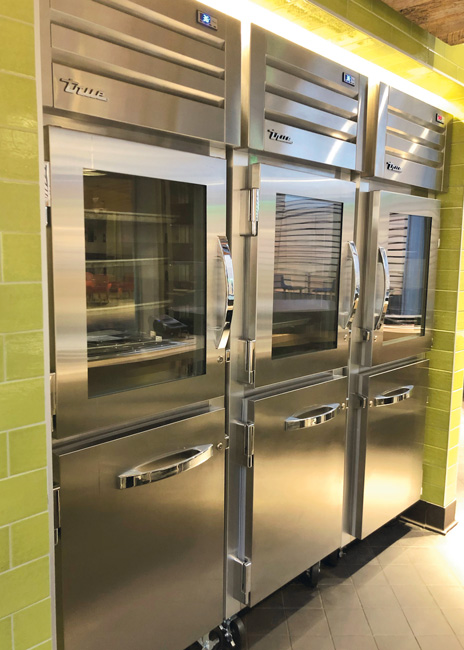 Sprout’s enlarged footprint includes more refrigeration and hot holding equipment.Chef’s Kitchen was used for COVID-19 testing, and once this effort was completed and retired this spring, the space converted back to its original dual purpose: a pop-up restaurant for lunch with a six-week rotating menu and a teaching/learning kitchen used for chef demonstrations, cooking classes, catering and team building, and full-service events at non-lunchtime hours. “We were intentional about the venue being designed to allow the flexibility for minor enhancements and major renovations so we can totally change the platform and program of culinary offerings,” Coffey says. “This allows much more flexibility to the lunch pop-up concept so we can offer more diverse, authentic cultural offerings and programming for student engagement cooking classes and demos,” Coffey says.
Sprout’s enlarged footprint includes more refrigeration and hot holding equipment.Chef’s Kitchen was used for COVID-19 testing, and once this effort was completed and retired this spring, the space converted back to its original dual purpose: a pop-up restaurant for lunch with a six-week rotating menu and a teaching/learning kitchen used for chef demonstrations, cooking classes, catering and team building, and full-service events at non-lunchtime hours. “We were intentional about the venue being designed to allow the flexibility for minor enhancements and major renovations so we can totally change the platform and program of culinary offerings,” Coffey says. “This allows much more flexibility to the lunch pop-up concept so we can offer more diverse, authentic cultural offerings and programming for student engagement cooking classes and demos,” Coffey says.
The venue’s clean, modern design includes 16 teaching pods. Each pod contains an induction cooktop, mixers, food processors and all smallwares for prep, cooking and baking needs. In addition, participants have access to individual ovens standing along Chef’s Kitchen cookline, flanked on the two end walls.
Guests can catch the chefs’ actions on mirrors, cameras and digital screens. “Students have a huge interest in learning to cook and to cook healthy,” Coffey says. “They watch cooking shows and want to learn. We’ve been bringing in national, regional and local chefs to do demos in this state-of-the-art facility.”
The main addition here, a food shield, lowers and raises depending on the menu offerings. “This rises for the serving line and looks like part of the counter when lowered,” Coffey says. “The flexibility of the sneeze guards to be lowered and counters to be moved supports the many different uses Chef Kitchen offers.”
Chef’s Kitchen also added induction cooktops that culinary staff use for pop-up lunches. “This gives us the flexibility to use multiple different serviceware and setup styles because every six weeks or so, we are providing a new concept, which requires many different food offerings and approaches for service line layout and setup.”
Panera Bread replaces Au Bon Pain. “We worked with Panera Bread to accommodate the look and feel of their corporate brand for their new Brodhead Center location, while taking into account Duke’s directives for high quality, durability and compatibility with the surrounding architecture,” Wentz says.
Panera features its signature sandwiches, soups and specialty salads made to order. The Panera equipment plan reused the walk-in cooler, walk-in freezer, ice bin, grease interceptor, three-compartment sink, data rack, soup retherm unit and hand sink. New equipment includes a proofer retarder, a rack oven, a dual-thickness bread slicer, a 60-inch catering prep cooler, a 60-inch main topping unit, 2 refrigerators, a refrigerated salad crisper, a microwave oven, a 14-well soup station, conveyor toasters, a 72-inch salad prep table, a high-speed oven and a bagel slicer. The Panera equipment lineup also includes self-service merchandiser cases and refrigerated grab-and-go units. In addition, this station contains a coffee brewer, tea brewer, whole-bean coffee grinder, espresso machine and other beverage dispensers.
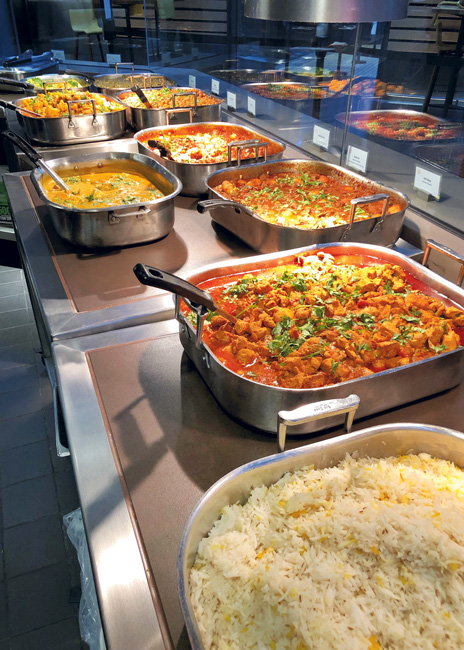 Induction cookers allow staff to prepare a wider variety of menu items at Tandoor than before the renovation. Photo courtesy of Duke DiningFor design, “Panera drew from their standard stock of finish options but leaned into the wood finishes for the exterior to flow into the Brodhead’s lowest floor level,” says Wentz. “Also, they used a dark blue ceramic accent tile to draw on university colors.”
Induction cookers allow staff to prepare a wider variety of menu items at Tandoor than before the renovation. Photo courtesy of Duke DiningFor design, “Panera drew from their standard stock of finish options but leaned into the wood finishes for the exterior to flow into the Brodhead’s lowest floor level,” says Wentz. “Also, they used a dark blue ceramic accent tile to draw on university colors.”
Maintaining a sustainable operation and continuing green practices challenged the project team working on Brodhead Center along with all other operations on Duke’s campus. “As we’ve transitioned back to indoor dining with COVID protocols, we have brought back our reusable container program,” Coffey says, adding, “We made a bold move not installing soda/drink fountains and instead went with hydration bars that contain fruit teas and water along with carbonated water and organic flavored syrups to be one’s own soda jerk.”
Since its inception, the Brodhead Center has attracted more customers who want to come together as a community in the heart of campus than originally anticipated. “The BHC is a retail dining center and not an all-you-care-to-eat venue,” Coffey says. “BHC has attracted more business than predicted, pulling in more faculty, staff, graduate students, medical campus members and guests than we anticipated.”
Duke Dining’s initial vision for Brodhead Center lived up to its potential, allowing project teams to easily transform dining venues to enhance current options and even offer entirely new ones. And this is just the beginning.
Additionally, Ginger + Soy along with Gyotaku will be renovated this summer 2022, and new venues — Thai Entrees, Yubu Boats and Battera Sushi — will be added to the menu with this renovation, Coffey says.
Facts of Note
Renovation: May 2021 to August 2021
About Duke University foodservice: Campus foodservice includes more than 35 restaurants and cafes, including the Brodhead Center venues and East Union Marketplace, a traditional all-you-care-to-eat residential dining facility for first-year students with a dining plan. In addition, a variety of off-campus restaurants deliver to residence halls, and five food trucks come to campus.
Brodhead Center restaurants:
- The ground floor: Devil’s Krafthouse, Panera Bread and the back-of-the-house kitchen
- The plaza (first level): Farmstead, Sprout, Tandoor, Ginger + Soy, Gyotaku, Il Forno, JB’s Roast & Chops, Sazón, Skillet and Cafe
- The mezzanine (second level): Chef’s Kitchen
- Top floor (third level): Commons
Scope of project: Refresh of four concepts: Sprout, Farmstead, Tandoor and Chef’s Kitchen, plus replacement of Au Bon Pain with Panera Bread
Total size of Brodhead Center: 113,000 sq. ft.
Refreshed restaurants without seating:
- Sprout: 176 sq. ft. (additional kitchen prep space on floor below)
- Farmstead: 404 sq. ft. (additional kitchen prep space on floor below)
- Tandoor: 387 sq. ft. (additional kitchen prep space on floor below)
- Panera Bread: 2,022 sq. ft.
- Chef’s Kitchen: 1,174 sq. ft.
- Seats: 995 in Brodhead Center
Average check: $10 for each restaurant
Total annual sales: $14 million (anticipated for 2022)
Daily transactions/covers: 10,500-plus on peak days, Monday through Thursday
Foodservice hours:
- Panera Bread: 7:30 a.m. to 8 p.m.
- Sprout, Farmstead and Tandoor: 11 a.m. until 9 p.m.
- Chef’s Kitchen: 11 a.m. to 2 p.m.
Menu concepts: Sprout with vegan and raw selections; Farmstead, a garden market with farm-to-fork sustainability featuring local ingredients in menu items; Tandoor with Indian cuisine; Chef’s Kitchen, which features pop-up menus that change every 4 to 6 weeks and also serves as a teaching/learning kitchen; and Panera Bread with signature sandwiches, soups and specialty salads made fresh to order
Staff: 250 to 300 in Brodhead Center before COVID-19; currently, 200 to 225 on average
Total renovation project cost: $1.5 million
Equipment investment: Approximately $375,000 (25% of $1.5 million)
Website: studentaffairs.duke.edu/dining
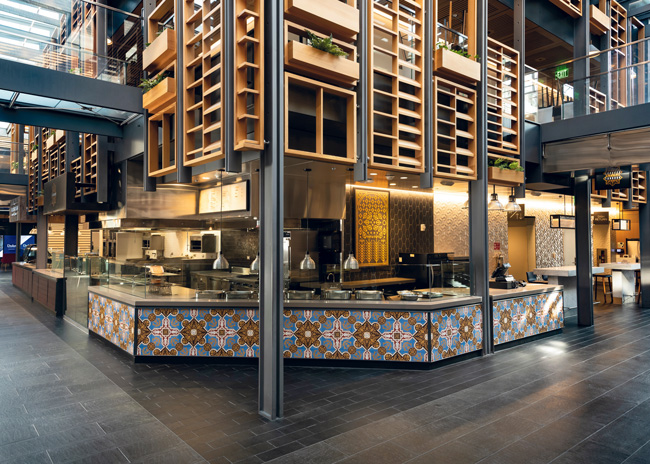 Tandoor’s facelift includes the addition of new Indian-style patterned tiles.
Tandoor’s facelift includes the addition of new Indian-style patterned tiles.
Key Players
Owner: Duke University, Durham, N.C.
Vice provost/vp, Duke Student Affairs: Mary Pat McMahon
Executive director of Duke Dining: Robert Coffey
Director of retail operations: Aris Marton
Duke project manager: Steve Carrow
Architect and interior design: New City Design Group, Raleigh, N.C.: Ted Van Dyk, AIA, principal; Peter J. Wentz, AIA, project architect
Equipment dealer: United Restaurant Equipment, Raleigh, N.C., for all except Panera
General contractor: LeChase Construction Service, local office in Durham, N.C.



